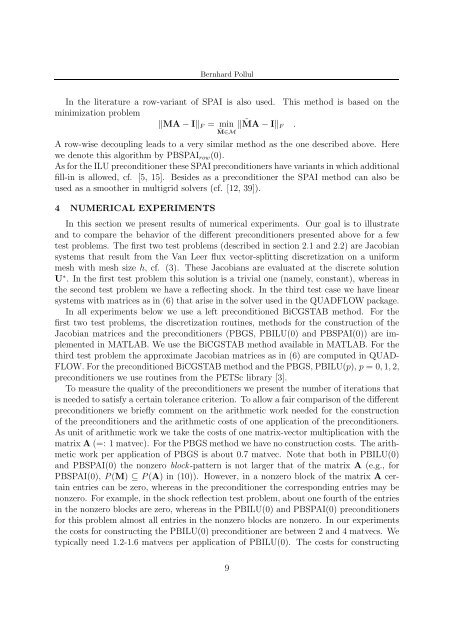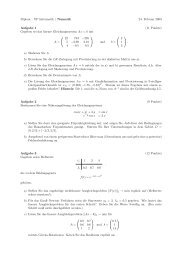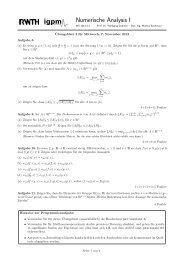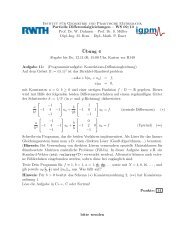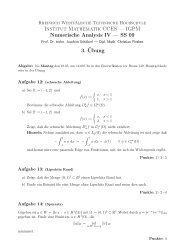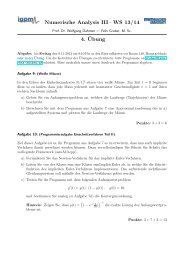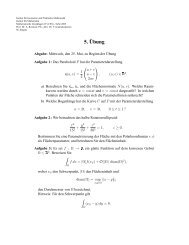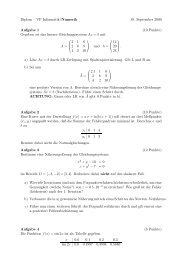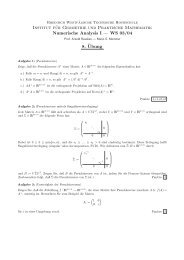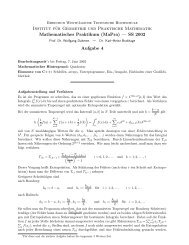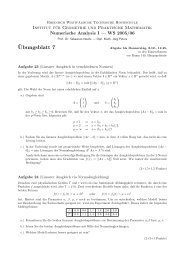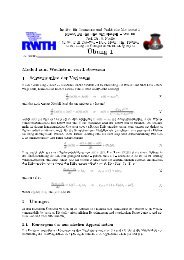preconditioners for linearized discrete compressible euler equations
preconditioners for linearized discrete compressible euler equations
preconditioners for linearized discrete compressible euler equations
Create successful ePaper yourself
Turn your PDF publications into a flip-book with our unique Google optimized e-Paper software.
Bernhard Pollul<br />
In the literature a row-variant of SPAI is also used. This method is based on the<br />
minimization problem<br />
‖MA − I‖ F = min ‖ ˜MA − I‖ F .<br />
˜M∈M<br />
A row-wise decoupling leads to a very similar method as the one described above. Here<br />
we denote this algorithm by PBSPAI row (0).<br />
As <strong>for</strong> the ILU preconditioner these SPAI <strong>preconditioners</strong> have variants in which additional<br />
fill-in is allowed, cf. [5, 15]. Besides as a preconditioner the SPAI method can also be<br />
used as a smoother in multigrid solvers (cf. [12, 39]).<br />
4 NUMERICAL EXPERIMENTS<br />
In this section we present results of numerical experiments. Our goal is to illustrate<br />
and to compare the behavior of the different <strong>preconditioners</strong> presented above <strong>for</strong> a few<br />
test problems. The first two test problems (described in section 2.1 and 2.2) are Jacobian<br />
systems that result from the Van Leer flux vector-splitting discretization on a uni<strong>for</strong>m<br />
mesh with mesh size h, cf. (3). These Jacobians are evaluated at the <strong>discrete</strong> solution<br />
U ∗ . In the first test problem this solution is a trivial one (namely, constant), whereas in<br />
the second test problem we have a reflecting shock. In the third test case we have linear<br />
systems with matrices as in (6) that arise in the solver used in the QUADFLOW package.<br />
In all experiments below we use a left preconditioned BiCGSTAB method. For the<br />
first two test problems, the discretization routines, methods <strong>for</strong> the construction of the<br />
Jacobian matrices and the <strong>preconditioners</strong> (PBGS, PBILU(0) and PBSPAI(0)) are implemented<br />
in MATLAB. We use the BiCGSTAB method available in MATLAB. For the<br />
third test problem the approximate Jacobian matrices as in (6) are computed in QUAD-<br />
FLOW. For the preconditioned BiCGSTAB method and the PBGS, PBILU(p), p = 0, 1, 2,<br />
<strong>preconditioners</strong> we use routines from the PETSc library [3].<br />
To measure the quality of the <strong>preconditioners</strong> we present the number of iterations that<br />
is needed to satisfy a certain tolerance criterion. To allow a fair comparison of the different<br />
<strong>preconditioners</strong> we briefly comment on the arithmetic work needed <strong>for</strong> the construction<br />
of the <strong>preconditioners</strong> and the arithmetic costs of one application of the <strong>preconditioners</strong>.<br />
As unit of arithmetic work we take the costs of one matrix-vector multiplication with the<br />
matrix A (=: 1 matvec). For the PBGS method we have no construction costs. The arithmetic<br />
work per application of PBGS is about 0.7 matvec. Note that both in PBILU(0)<br />
and PBSPAI(0) the nonzero block-pattern is not larger that of the matrix A (e.g., <strong>for</strong><br />
PBSPAI(0), P(M) ⊆ P(A) in (10)). However, in a nonzero block of the matrix A certain<br />
entries can be zero, whereas in the preconditioner the corresponding entries may be<br />
nonzero. For example, in the shock reflection test problem, about one fourth of the entries<br />
in the nonzero blocks are zero, whereas in the PBILU(0) and PBSPAI(0) <strong>preconditioners</strong><br />
<strong>for</strong> this problem almost all entries in the nonzero blocks are nonzero. In our experiments<br />
the costs <strong>for</strong> constructing the PBILU(0) preconditioner are between 2 and 4 matvecs. We<br />
typically need 1.2-1.6 matvecs per application of PBILU(0). The costs <strong>for</strong> constructing<br />
9


